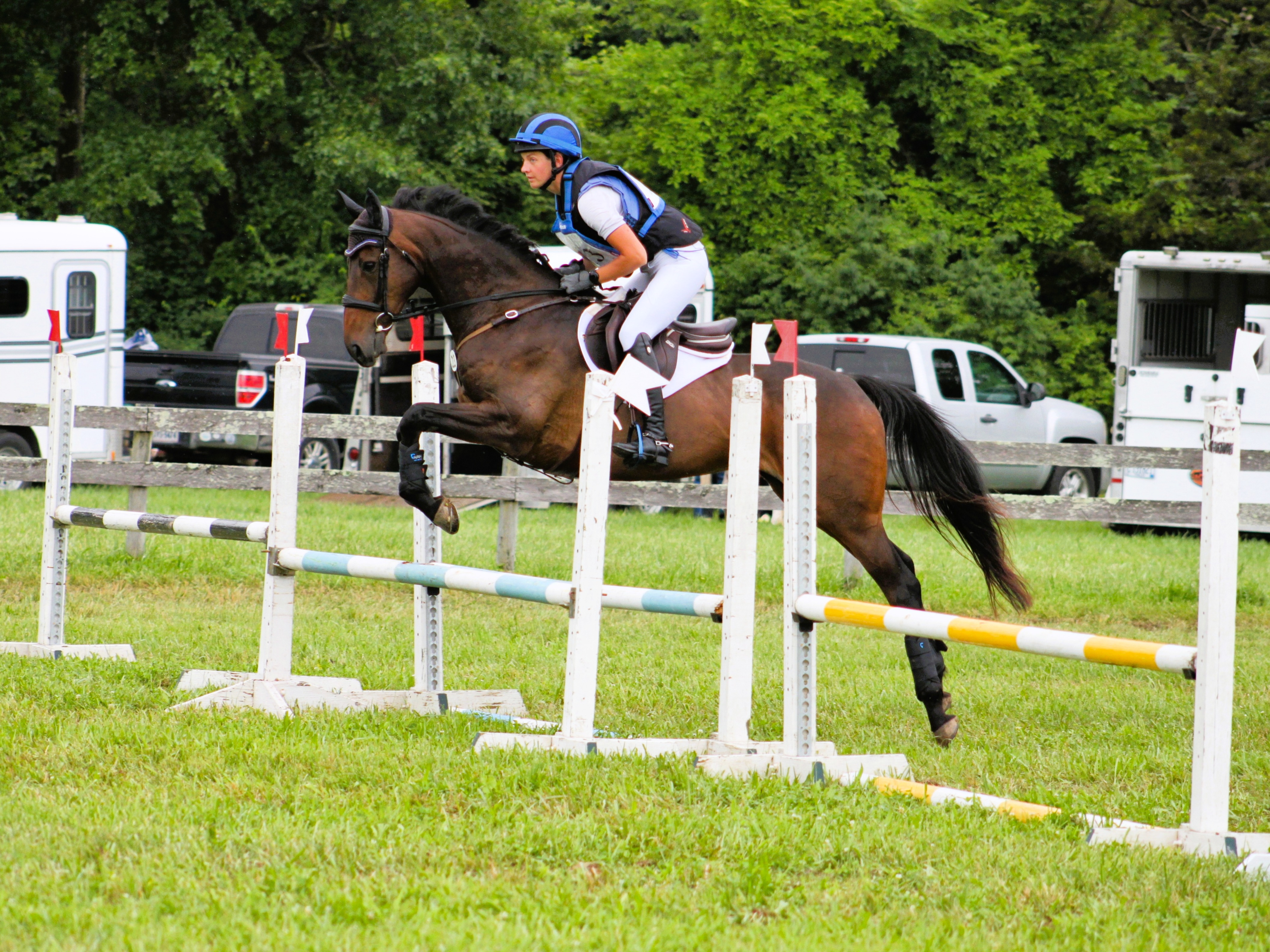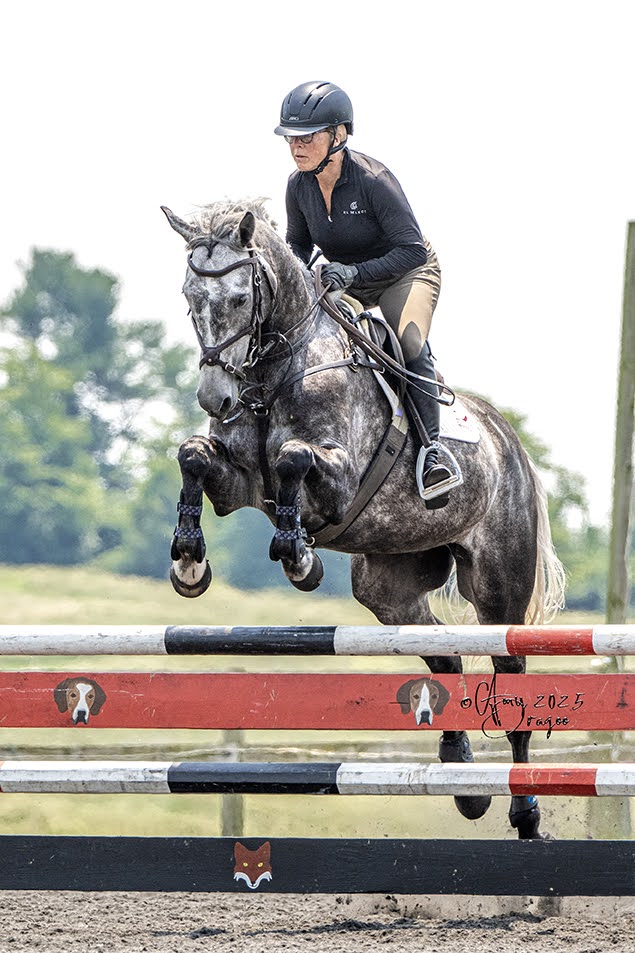Thoroughbred racehorses that go on to second careers are unique in that they have two retirements in their lifetimes: the first from the track and the second from the show ring. Thoroughbred Legends, a new EN series presented by Cosequin, seeks to honor off-track Thoroughbreds that went on to accomplish great things as upper-level eventers and now enjoy a second retirement in their golden years. If you know of a great Thoroughbred for this series, email [email protected].

Jackson as a yearling. Photo by Elisa Wallace.
In the summer of 2000, 18-year-old Elisa Wallace was perusing the internet for a horse of her own, having saved up all of her high school graduation money. In Lola, Kansas, there was an ad for a yearling Thoroughbred colt for sale $600. After calling the number and speaking with the owner, Elisa received a VHS video of the scraggly yearling running about with his mother and his half brother. “There was one moment in the video, when Jack was trotting and he tripped and then fell into an extended trot,” Elisa said. “I was sold. I had butterflies, and I knew in my gut that he was my horse.”
By September, Elisa had saved enough money to purchase the colt and drive 14 hours to Kansas to get him with a borrowed trailer and her mother as co-pilot. As they travelled, the windshield wipers on the truck failed, but they continued regardless. They hit a gruesome accident in Tennessee and then entered an enormous swarm of locusts in Missouri. In Kansas, they witnessed a lightening bolt blow up a tree right beside the road and Elisa saw her first funnel cloud, and they drove faster to avoid the oncoming tornado. They finally arrived, and Jack loaded right up on the trailer with the hint of some sweet feed. Elisa was now the proud owner of an unraced Thoroughbred out of Private Vacation by Gemini Dreamer.
“There were a lot of people who thought I was crazy to get a yearling,” Elisa said. “I didn’t have a barn or really any place to keep him.” Ready to start her first semester at Georgia State University, Elisa was still living with her mother and decided that she could build a stall in her basement and turn her horse out in the backyard. While she didn’t have a place to begin riding Jack, she worked on the ground with him a lot and used poles and tricks to get his mind and body attentive to her as a trainer. For more exercise, she would walk him along the road and around her block. Luckily for her, Karen McGoldrick, a well-respected dressage trainer, moved in next door and planned on building an indoor arena and equestrian center. Elisa was able to make a deal to work in exchange for use of the facilities.

Jackson and Elisa at the AECs. Photo by Beth Gordon.
At the age of 3, Elisa finally gelded Jack after finding out most boarding operations didn’t accept stallions. She competed him in a dressage show in Conyers, Ga., and at 3 years of age, he scored well, and she was quite proud. At the age of 5, he went to his first event at the Canterbury Horse Trials in Gainsville, Fla. He scored a 26 on the flat and won his first Novice event. After six Novice level horse trials, they went ahead and did the minimum qualifications for the next levels, winning his first Preliminary, placing third in his first CCI* long format event, and usually placing in the top five — if not the top three — every time out.
Jack was known as a people horse and a huge jokester in the barn. He had a big goofball personality and was prone to chewing on things if left within his reach. Under saddle, he was the quintessential kicking ride, but when on course at the upper levels was able to find a new gear and really turn on the gas. He has always been terrified of rocks and small beginner novice jumps, but when pointed at a larger obstacle, he was more than happy to go over it. “The harder the cross-country questions, the more he seemed to enjoy figuring out the answers,” Elisa said. “He always galloped on a loopy rein, and the jumps were always effortless.”
In 2006, they moved up to the Advanced level and finished fourth in their first attempt. After this, Elisa decided to head to her first CIC3* at Maui Jim in Illinois and use it as a qualifier for Fair Hill CCI3* in the fall. They scored a solid test in the dressage to sit in 12th place and zipped around a tough cross-country course to sit second going into show jumping. As the poles kept dropping and the leader had one too many rails, Elisa had just won her first three-star. “That event was pivotal for me,” Elisa said. “My dreams were coming true, and I had an amazing horse and we were on our way!”

Jackson in retirment. Photo by Elisa Wallace.
As the fall progressed, they readied themselves for Fair Hill CCI3*. After arriving in Maryland, Elisa was barely able to believe her luck — riding this amazing horse at her first CCI3*! A good dressage test put them in 16th place going into cross country. Jack warmed up for cross country well and went out on course feeling confident. However, they suffered a glance-off at a skinny following a drop, which was unusual for him. They had another run out at the coffin, and Jack was peeking really hard at the fences, which Elisa had never experienced before. He crossed the finish line and cooled out well, but she was frustrated with the performance. Unfortunately, upon returning to the barns, it was clear that something was wrong because he was dead lame in his left front leg. An ultrasound revealed a tear in a tendon, and Elisa felt horrible for pushing him when he was injured.
After a six-month healing period, the vets were happy to discover that his tendon had recovered well, and they were cleared for work again. In the spring, they ran the Pan Am Selection trials at Jersey Fresh, finishing with only a rail to add to their dressage score. Elisa was offered a blank check for Jack, but she couldn’t bring herself to sell him and brought him home with new goals. She wanted to go to Blenheim CCI3* and had fundraised enough to cover the expenses. First, she was to go to Millbrook to run the Advanced before shipping him to England.
After winning the dressage at Millbrook, she took her time on cross country, but jumped clean in the show jumping the next day to finish fourth overall. Jack loaded up to go to Jimmy Wofford’s farm in Virginia for a layover before England. Sadly, the next day he came out of the stall lame on the same left front, and Elisa was heartbroken. After an ultrasound found nothing in the old tendon, an MRI revealed that he had torn a tendon in his hoof, and he would never be sound enough for competition again.
Jack was able to teach some lessons after this, but was always mildly uncomfortable afterwards, so Elisa decided to fully retire him to the life of a wild pasture ornament. He lives in her back pasture and mentors her young horses. “As riders, trainers and horse lovers, we are so lucky to have these magical creatures come into our lives,” Elisa said. “Jackson taught me so much: patience, determination, humility and faith. I know that I made some mistakes in some of my decisions with him, and all I can do is make sure that I learn from him. Probably most of all, he has taught me to listen, and oftentimes horses are telling us something, but we are too deaf to hear.
“Every now and then, I will go to the back pasture and give Jack a hug around the neck. It seems to satisfy us both, and I feel my heart smile. He gives the best hugs, and even when I’m having a bad day, he makes it all better. I still ask him, ‘Jackson, are you the best horse ever?’ And he, of course, nods his head, ‘Yes.'”






































































